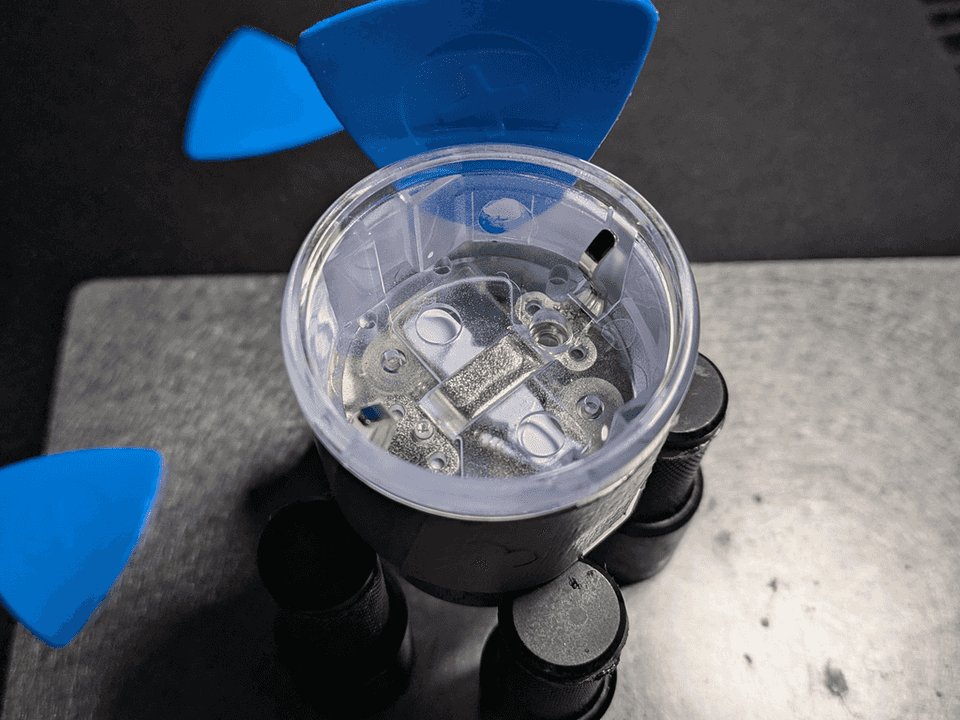devices.esphome.io
Shelly Plug S Gen3
Shelly Plug S Gen3
Device Type: plugElectrical Standard: euBoard: esp32c3Difficulty: Soldering required, 4/5
Generation 3 of Shelly Plug-S
At this moment there is NO way to Flash it OTA. You need to open the Plug and use UART!
As always, first take a dump!
esptool -b 115200 --port COM11 read_flash 0x00000 0x800000 shelly_plug_s_gen3.bin
UART Pinout
| Pin | Colour |
|---|---|
| Reset | Brown |
| 3v3 | Red |
| RX | Blue |
| TX | Yellow |
| BootSEL | Purple |
| GND | Black |

GPIO Pinout
| Pin | Function |
|---|---|
| GPIO3 | Internal Temperature |
| GPIO4 | LED WS2812 |
| GPIO5 | Relay |
| GPIO6 | BL0942 TX |
| GPIO7 | BL0942 RX |
| GPIO18 | Button |
substitutions: device_name: shelly-plug-s-gen3 friendly_name: "Shelly Plug S Gen3" ip_addr: 10.0.x.x update_bl0942: 5s
esphome: name: ${device_name} friendly_name: ${friendly_name} comment: "Free Shelly!" platformio_options: board_build.flash_mode: dio
esp32: board: esp32-c3-devkitm-1 flash_size: 8MB framework: type: esp-idf version: recommended sdkconfig_options: COMPILER_OPTIMIZATION_SIZE: y
wifi: ssid: !secret wifi_ssid password: !secret wifi_password ap: ssid: "FreeShelly Hotspot" password: !secret wifi_password
logger:
api: encryption: key: !secret api_encryption_key
ota: - platform: esphome password: !secret ota_password
captive_portal:
binary_sensor: - platform: gpio id: "push_button" name: "Button" internal: true pin: number: GPIO18 inverted: yes mode: input: true pullup: true filters: - delayed_on_off: 5ms
switch: - platform: gpio pin: GPIO4 name: "Relay"
light: - platform: esp32_rmt_led_strip rgb_order: GRB rmt_channel: 0 chipset: pin: GPIO4 num_leds: 4 id: rgb_light1 internal: false default_transition_length: 700ms restore_mode: ALWAYS_OFF
uart: id: uart_0 tx_pin: GPIO7 rx_pin: GPIO6 baud_rate: 9600 stop_bits: 1 data_bits: 8 parity: NONE
sensor: - platform: ntc sensor: temp_resistance_reading name: "Temperature" unit_of_measurement: "°C" accuracy_decimals: 1 icon: "mdi:thermometer" calibration: b_constant: 3350 reference_resistance: 10kOhm reference_temperature: 298.15K - platform: resistance id: temp_resistance_reading sensor: temp_analog_reading configuration: DOWNSTREAM resistor: 10kOhm - platform: adc id: temp_analog_reading pin: GPIO3 attenuation: 12db
- platform: bl0942 uart_id: uart_0 address: 0 voltage: name: 'Voltage' id: bvoltage icon: mdi:alpha-v-circle-outline device_class: voltage current: name: 'Current' id: bcurrent icon: mdi:alpha-a-circle-outline device_class: current power: name: 'Power' id: bpower icon: mdi:transmission-tower device_class: power energy: name: 'Energy' id: benergy icon: mdi:lightning-bolt device_class: energy frequency: name: "Frequency" id: bfreq accuracy_decimals: 2 icon: mdi:cosine-wave device_class: frequency update_interval: ${update_bl0942}Open the device
![Seal [thx to bkbartk] Seal](/static/20afbdd824ea5f8d0cfcaec92c316148/02e12/seal(plombe).jpg)

When the seal is cracked open, you need a M2 drill, and drill in center, just a little.

Now take a tapered punch and press the seal out. The whole grounding receptacle will come out.
We need some hot-air (~300°C) and 5 of the iFixit triangle-plastic, there are 3 spots with glue.
Heat them up, and try placeing the plastic around.

You will get a little gap, take anohter plastic and g et betweet the withe and transparent plastic, and make a circle.

After 2 rounds you can easly take it out.
Edit this page on GitHub